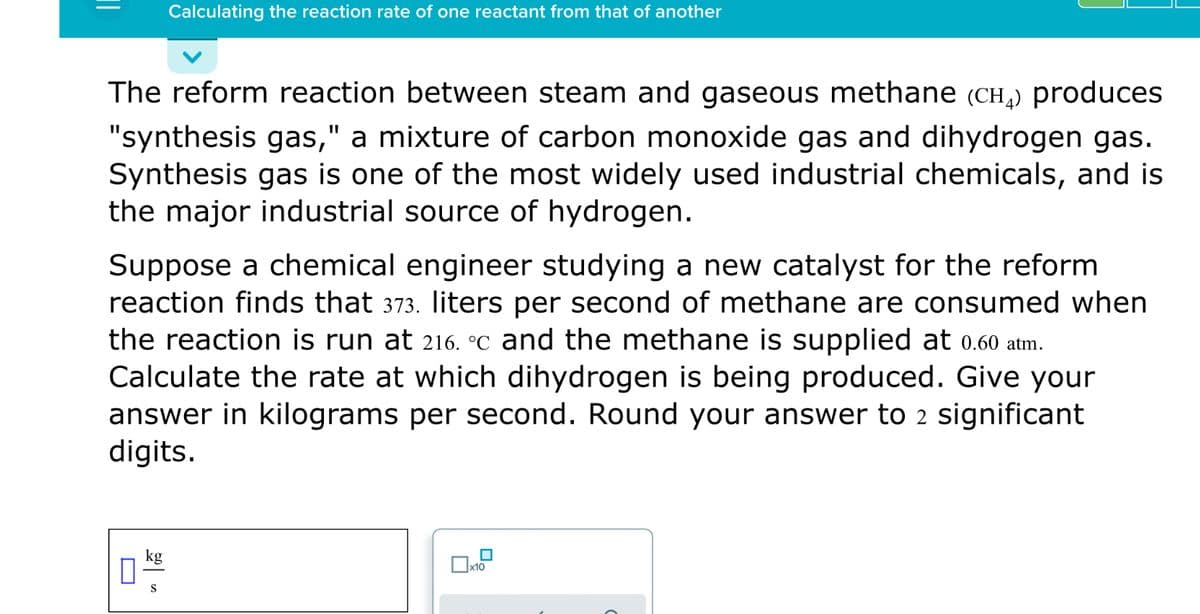The reform reaction between steam and gaseous methane (CH,) produces "synthesis gas," a mixture of carbon monoxide gas and dihydrogen gas. Synthesis gas is one of the most widely used industrial chemicals, and is the major industrial source of hydrogen. Suppose a chemical engineer studying a new catalyst for the reform reaction finds that 373. liters per second of methane are consumed when the reaction is run at 216. °C and the methane is supplied at 0.60 atm. Calculate the rate at which dihydrogen is being produced. Give your answer in kilograms per second. Round your answer to 2 significant digits. kg
The reform reaction between steam and gaseous methane (CH,) produces "synthesis gas," a mixture of carbon monoxide gas and dihydrogen gas. Synthesis gas is one of the most widely used industrial chemicals, and is the major industrial source of hydrogen. Suppose a chemical engineer studying a new catalyst for the reform reaction finds that 373. liters per second of methane are consumed when the reaction is run at 216. °C and the methane is supplied at 0.60 atm. Calculate the rate at which dihydrogen is being produced. Give your answer in kilograms per second. Round your answer to 2 significant digits. kg
Chemistry
10th Edition
ISBN:9781305957404
Author:Steven S. Zumdahl, Susan A. Zumdahl, Donald J. DeCoste
Publisher:Steven S. Zumdahl, Susan A. Zumdahl, Donald J. DeCoste
Chapter5: Gases
Section: Chapter Questions
Problem 101E: At elevated temperatures, sodium chlorate decomposes to produce sodium chloride and oxygen gas. A...
Related questions
Question

Transcribed Image Text:Calculating the reaction rate of one reactant from that of another
The reform reaction between steam and gaseous methane (CH,) produces
"synthesis gas," a mixture of carbon monoxide gas and dihydrogen gas.
Synthesis gas is one of the most widely used industrial chemicals, and is
the major industrial source of hydrogen.
Suppose a chemical engineer studying a new catalyst for the reform
reaction finds that 373. liters per second of methane are consumed when
the reaction is run at 216. °c and the methane is supplied at 0.60 atm.
Calculate the rate at which dihydrogen is being produced. Give your
answer in kilograms per second. Round your answer to 2 significant
digits.
kg
|x10
S
Expert Solution
This question has been solved!
Explore an expertly crafted, step-by-step solution for a thorough understanding of key concepts.
Step by step
Solved in 3 steps

Knowledge Booster
Learn more about
Need a deep-dive on the concept behind this application? Look no further. Learn more about this topic, chemistry and related others by exploring similar questions and additional content below.Recommended textbooks for you

Chemistry
Chemistry
ISBN:
9781305957404
Author:
Steven S. Zumdahl, Susan A. Zumdahl, Donald J. DeCoste
Publisher:
Cengage Learning

Chemistry: An Atoms First Approach
Chemistry
ISBN:
9781305079243
Author:
Steven S. Zumdahl, Susan A. Zumdahl
Publisher:
Cengage Learning


Chemistry
Chemistry
ISBN:
9781305957404
Author:
Steven S. Zumdahl, Susan A. Zumdahl, Donald J. DeCoste
Publisher:
Cengage Learning

Chemistry: An Atoms First Approach
Chemistry
ISBN:
9781305079243
Author:
Steven S. Zumdahl, Susan A. Zumdahl
Publisher:
Cengage Learning


Principles of Modern Chemistry
Chemistry
ISBN:
9781305079113
Author:
David W. Oxtoby, H. Pat Gillis, Laurie J. Butler
Publisher:
Cengage Learning

Chemistry: Principles and Practice
Chemistry
ISBN:
9780534420123
Author:
Daniel L. Reger, Scott R. Goode, David W. Ball, Edward Mercer
Publisher:
Cengage Learning

Chemistry by OpenStax (2015-05-04)
Chemistry
ISBN:
9781938168390
Author:
Klaus Theopold, Richard H Langley, Paul Flowers, William R. Robinson, Mark Blaser
Publisher:
OpenStax